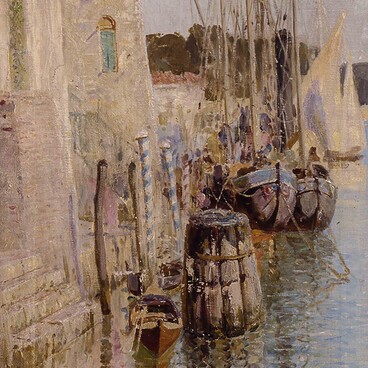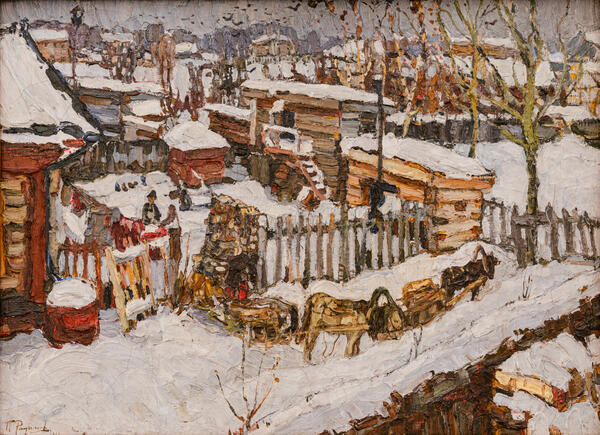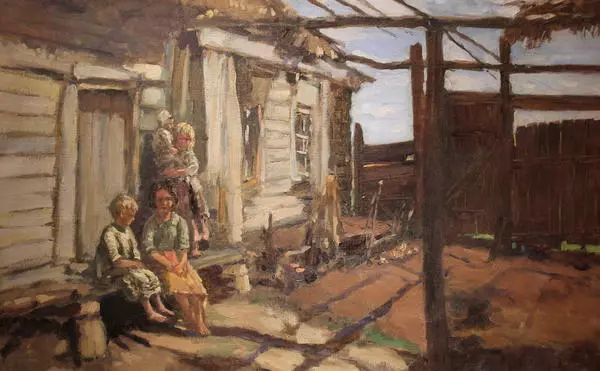The landscapes, located above the desk in Nikolai Golovanov’s office, include one of the works by the artist Pavel Radimov called “The Assumption Cathedral of the Moscow Kremlin”.
Pavel Alexandrovich Radimov liked to depict monuments of Russian antiquity. The artist was especially good at small-scale painting. Radimov did not have an art education: he studied at a theological seminary, graduated from the Faculty of History and Philology of Kazan University, and wrote poetry. Pavel Radimov once presented Golovanov with a collection of his poems called “Field Psalms”, published in 1912. Radimov took lessons from the Russian and American artist Nicolai Ivanovich Fechin, and in 1914 became a member of the Society for Traveling Art Exhibitions. In the early 1940s, Radimov and his brother Ivan (also an artist) painted a portrait of Golovanov. Two sketches and one final portrait are currently housed in the Nikolai Golovanov Apartment Museum.
Nikolai Semyonovich had quite a few views of churches in his collection, and the view of the Assumption Cathedral of the Moscow Kremlin was there for a special reason. The Feast of the Dormition of the Theotokos and the Assumption Cathedral were of great importance to the conductor. On the Feast of the Dormition (August 28), Golovanov entered the Synodal School, which marked the beginning of his career as a musician. Golovanov’s first performance with the choir also took place on the day of the feast. Nikolai Golovanov participated in the services held in the Assumption Cathedral as a chorister, cantor, and soloist. Nikolai Semyonovich recalled in his autobiography, “The Synodal choir, which performed in the ancient Assumption Cathedral of the Moscow Kremlin, consisted of a hundred singers: boys who went to the Synodal School and civilians, who were selected in the competition of adult singers. It was a superbly well-trained ensemble that won worldwide fame.” As if to confirm his personal connection with the Feast of the Dormition, Golovanov ended his first magnum opus with kontakia of Saint Nicholas and the Dormition of the Most Holy Theotokos. August 28, when the Feast of the Dormition of the Most Holy Theotokos is celebrated, became the day when Nikolai Golovanov died — a final testament to how strong his ties with Eastern Orthodoxy were.
Pavel Alexandrovich Radimov liked to depict monuments of Russian antiquity. The artist was especially good at small-scale painting. Radimov did not have an art education: he studied at a theological seminary, graduated from the Faculty of History and Philology of Kazan University, and wrote poetry. Pavel Radimov once presented Golovanov with a collection of his poems called “Field Psalms”, published in 1912. Radimov took lessons from the Russian and American artist Nicolai Ivanovich Fechin, and in 1914 became a member of the Society for Traveling Art Exhibitions. In the early 1940s, Radimov and his brother Ivan (also an artist) painted a portrait of Golovanov. Two sketches and one final portrait are currently housed in the Nikolai Golovanov Apartment Museum.
Nikolai Semyonovich had quite a few views of churches in his collection, and the view of the Assumption Cathedral of the Moscow Kremlin was there for a special reason. The Feast of the Dormition of the Theotokos and the Assumption Cathedral were of great importance to the conductor. On the Feast of the Dormition (August 28), Golovanov entered the Synodal School, which marked the beginning of his career as a musician. Golovanov’s first performance with the choir also took place on the day of the feast. Nikolai Golovanov participated in the services held in the Assumption Cathedral as a chorister, cantor, and soloist. Nikolai Semyonovich recalled in his autobiography, “The Synodal choir, which performed in the ancient Assumption Cathedral of the Moscow Kremlin, consisted of a hundred singers: boys who went to the Synodal School and civilians, who were selected in the competition of adult singers. It was a superbly well-trained ensemble that won worldwide fame.” As if to confirm his personal connection with the Feast of the Dormition, Golovanov ended his first magnum opus with kontakia of Saint Nicholas and the Dormition of the Most Holy Theotokos. August 28, when the Feast of the Dormition of the Most Holy Theotokos is celebrated, became the day when Nikolai Golovanov died — a final testament to how strong his ties with Eastern Orthodoxy were.







